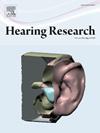Drug-induced hearing loss: a real-world pharmacovigilance study using the FDA adverse event reporting system database
IF 2.5
2区 医学
Q1 AUDIOLOGY & SPEECH-LANGUAGE PATHOLOGY
引用次数: 0
Abstract
Drug-induced hearing loss (DIHL) is highly prevalent, but a comprehensive picture of ototoxicity associated with drugs are still lacking. In order to comprehensively summarize the hearing safety information of current drugs, we used the real-world data from 2004 to 2023 in the FDA Adverse Event Reporting System (FAERS) database to integrate the reported ototoxicity information of drugs and applied disproportionality analysis to evaluate the hearing impairment risk induced by drugs. A total of 108,435 adverse event (AE) reports of hearing impairment were extracted from the FAERS database, involving 1300 reported culprit-drugs. On the whole, acetylsalicylic acid was the most frequently reported potential ototoxic drug, followed by levothyroxine sodium, adalimumab, omeprazole, and ergocalciferol. Immunosuppressants was the most frequently reported drug class, followed by analgesics, psychoanaleptics, agents acting on the renin-angiotensin system, and antineoplastic agents. In risk signal detection, 432 of 1300 drugs exhibited potential ototoxic risk, in which tafenoquine showed the strongest statistical correlation with hearing impairment, followed by teprotumumab, amyl nitrite, potassium iodide, and paromomycin. Among main drug classes, antibacterials for systemic use was the drug class contained the maximum number of drugs with positive ototoxic risk signals, followed by psychoanaleptics, agents acting on the renin-angiotensin system, antineoplastic agents, and analgesics. In conclusion, our study summarized a comprehensive drug list containing 1300 reported potential ototoxic drugs in the FAERS database and profiled their ototoxicity risk characteristic from the aspect of reporting frequency and risk signal strength, which can provide reference for clinical medical staff to strengthen monitoring and management of DIHL.
药物引起的听力损失:利用美国食品药物管理局不良事件报告系统数据库进行的真实世界药物警戒研究
药物性听力损失(DIHL)非常普遍,但对药物相关耳毒性的全面了解仍然缺乏。为了全面总结现有药物的听力安全信息,我们利用FDA不良事件报告系统(FAERS)数据库中2004 - 2023年的真实数据,对已报道的药物耳毒性信息进行整合,并应用歧化分析对药物引起的听力损害风险进行评价。从FAERS数据库中提取了108,435例听力损害不良事件(AE)报告,涉及1300例报告的罪魁祸首药物。总的来说,乙酰水杨酸是最常见的潜在耳毒性药物,其次是左甲状腺素钠、阿达木单抗、奥美拉唑和麦角钙化醇。免疫抑制剂是最常见的药物类别,其次是镇痛药、精神镇痛药、肾素-血管紧张素系统作用的药物和抗肿瘤药物。在风险信号检测中,1300种药物中有432种具有潜在的耳毒性风险,其中他非诺喹与听力损害的统计相关性最强,其次是特原单抗、亚硝酸盐戊酯、碘化钾和帕罗霉素。在主要药物类别中,具有耳毒性阳性风险信号的药物数量最多的是全系统使用的抗菌药物,其次是精神镇痛药、肾素-血管紧张素系统药物、抗肿瘤药物和镇痛药。综上所述,本研究总结了FAERS数据库中已报道的1300种潜在耳毒性药物的综合药物清单,并从报告频率和风险信号强度方面分析了其耳毒性风险特征,可为临床医务人员加强对DIHL的监测和管理提供参考。
本文章由计算机程序翻译,如有差异,请以英文原文为准。
求助全文
约1分钟内获得全文
求助全文
来源期刊

Hearing Research
医学-耳鼻喉科学
CiteScore
5.30
自引率
14.30%
发文量
163
审稿时长
75 days
期刊介绍:
The aim of the journal is to provide a forum for papers concerned with basic peripheral and central auditory mechanisms. Emphasis is on experimental and clinical studies, but theoretical and methodological papers will also be considered. The journal publishes original research papers, review and mini- review articles, rapid communications, method/protocol and perspective articles.
Papers submitted should deal with auditory anatomy, physiology, psychophysics, imaging, modeling and behavioural studies in animals and humans, as well as hearing aids and cochlear implants. Papers dealing with the vestibular system are also considered for publication. Papers on comparative aspects of hearing and on effects of drugs and environmental contaminants on hearing function will also be considered. Clinical papers will be accepted when they contribute to the understanding of normal and pathological hearing functions.
 求助内容:
求助内容: 应助结果提醒方式:
应助结果提醒方式:


